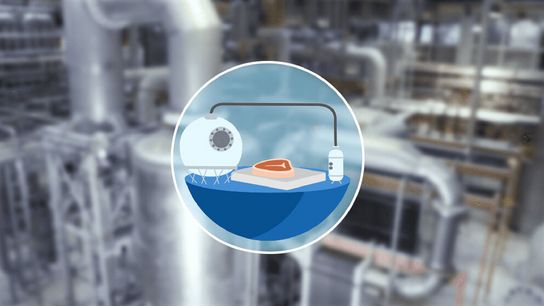Product quality of the highest standard
Gelatine is a pure collagenous protein that is obtained from animal raw materials. The majority of the gelatine that is manufactured in Europe comes from pork. Further kinds are made from bovine or fish raw materials. The type of raw material used in gelatine manufacturing depends on the livestock available in each region. The high quality standards for gelatine are ensured through the choice of raw materials and the production process.
Premium raw materials
Gelatine production is based on a careful selection of raw materials to ensure that safety and quality standards are met. European gelatine manufacturers use only raw materials from healthy pigs, cattle and fish. Furthermore, all GME members produce accordingly to ISO and/or other high level food safety and GMP standards. Thus, the gelatine industry is one of the best structured and best controlled industrial sectors in Europe.
Approximately 80 per cent of the edible gelatine produced in Europe is made from pork skins. Fifteen per cent is made from split. Split is a thin, collagen-containing layer of the cattle hide that lies between the epidermis and subcutaneous layer. The remaining 5 per cent of gelatine comes from porcine and bovine bones and fish.
Comprehensive European statutory provisions regulate the slaughter as well as the control and licensing procedures through government agencies. All raw materials are regularly inspected for safety and origin. The animals come only from licensed slaughterhouses and are first examined by veterinarians. Only raw materials that have been approved for human consumption are used to manufacture gelatine. In other words, the meat the consumer buys comes from the same healthy animal as the raw material used to make gelatine.
- Edible gelatine must meet the requirements mandated by the regulations on edible gelatine and is also subject to food law.
- Pharmaceutical gelatine must comply with the stringent requirements of the official pharmacopoeia.
High-tech production process
At GME member plants, gelatine is produced in a complex, multi-stage process using high-tech industrial equipment. The starting material is the connective tissue of pigs, cattle or fish. Collagenous protein is separated from pig, calf and cattle skin and bones and made into gelatine. The final product, gelatine, is a pure, high-grade protein.
The raw materials are first freed of fat and minerals. Then two different pre-treatment methods are used, depending upon the raw material and the intended application.
Alkaline process
Bovine connective tissue is densely interconnected and is therefore pre-treated with an alkaline solution for several weeks. This gently changes the collagen structure. Following this treatment, the collagen is soluble in warm water and can thus be separated from the remaining raw material.
Acid process
Collagenous porcine connective tissue is not as densely interconnected. Collagen extraction is already possible after one-day acid treatment followed by neutralisation and a thorough rinsing out of the salts.
The pre-treated raw materials are now mixed with hot drinking water and extracted in a multi-stage process. The temperature of the heated water is a parameter for gel strength: the lower the temperature of the water, the higher the gel strength, or Bloom value, of the extracted gelatine.
The extracted solutions are freed of traces of fat and fine fibres in high-performance separators. Just as in the beverage industry, the finest particles are removed through filtration. In a last purification step, the gelatine is freed of calcium, sodium, residual acid and other salts.
The gelatine solution is now concentrated in a vacuum evaporation system and thickened into a honey-like mass.
The highly concentrated gelatine solutions are sterilized, cooled, set and dried under strict hygienic conditions. This process results in “jelly noodles” that are ground into grains after drying.
The quality and purity of the gelatine is ensured through extensive quality controls in the laboratory. All of these steps are indispensable in gelatine production and have been used for decades to manufacture high-grade gelatine.

